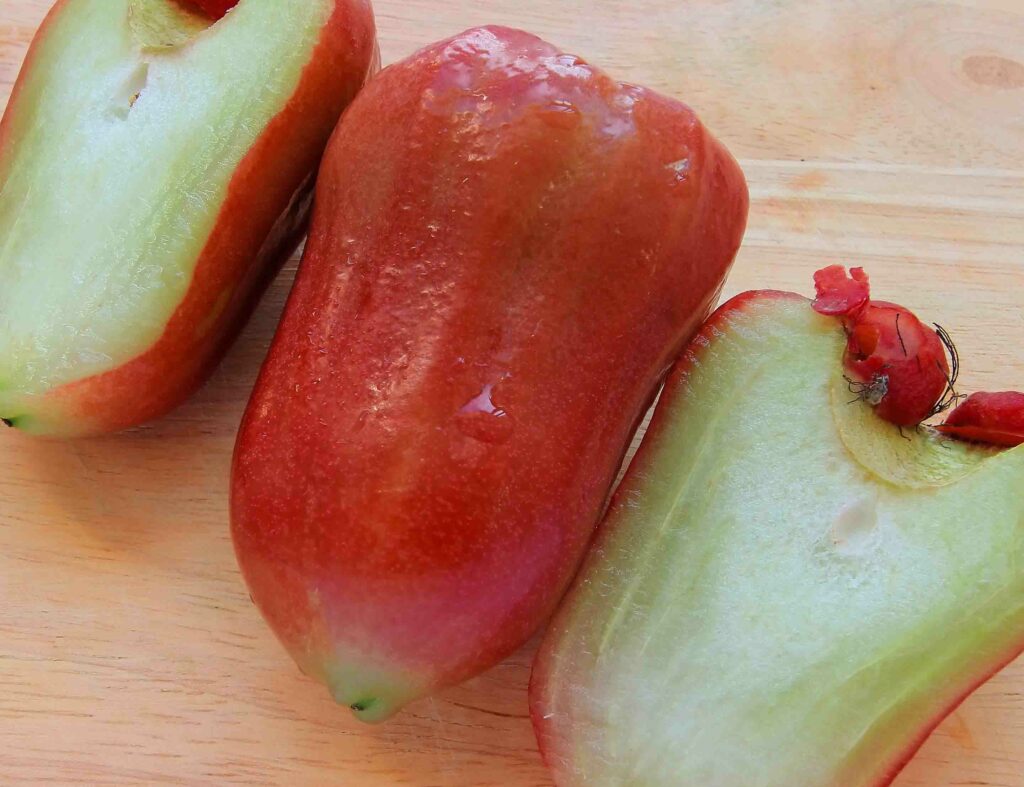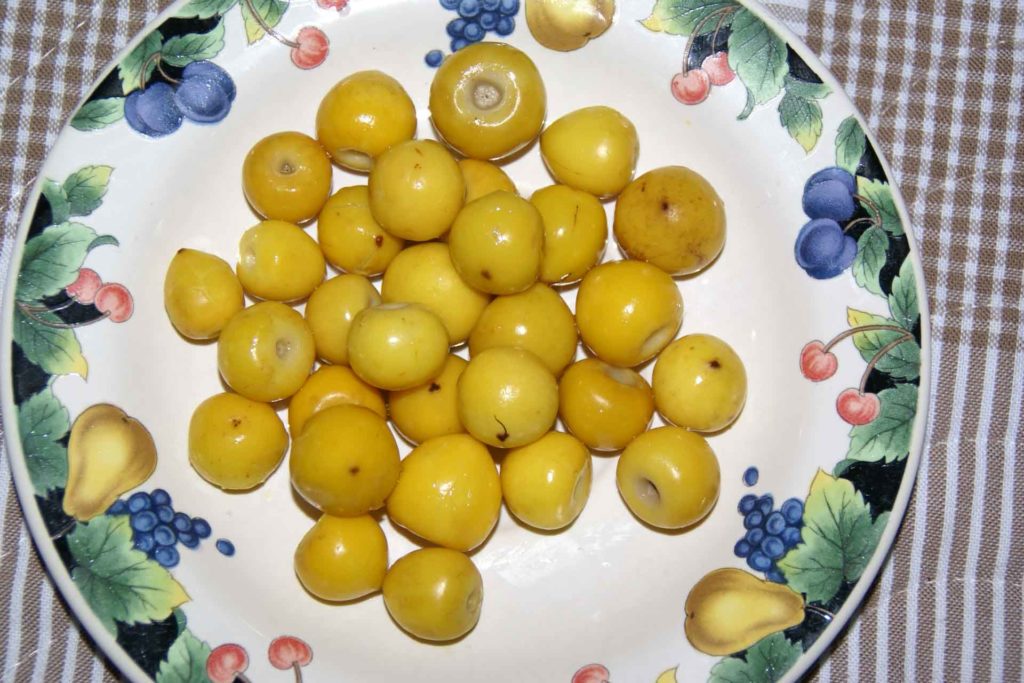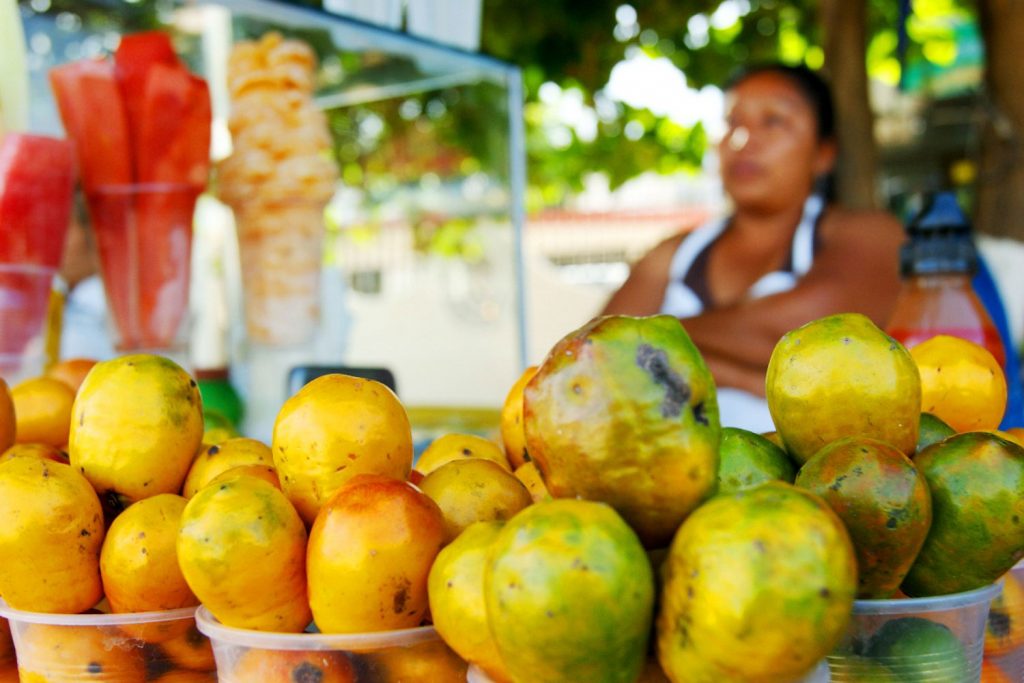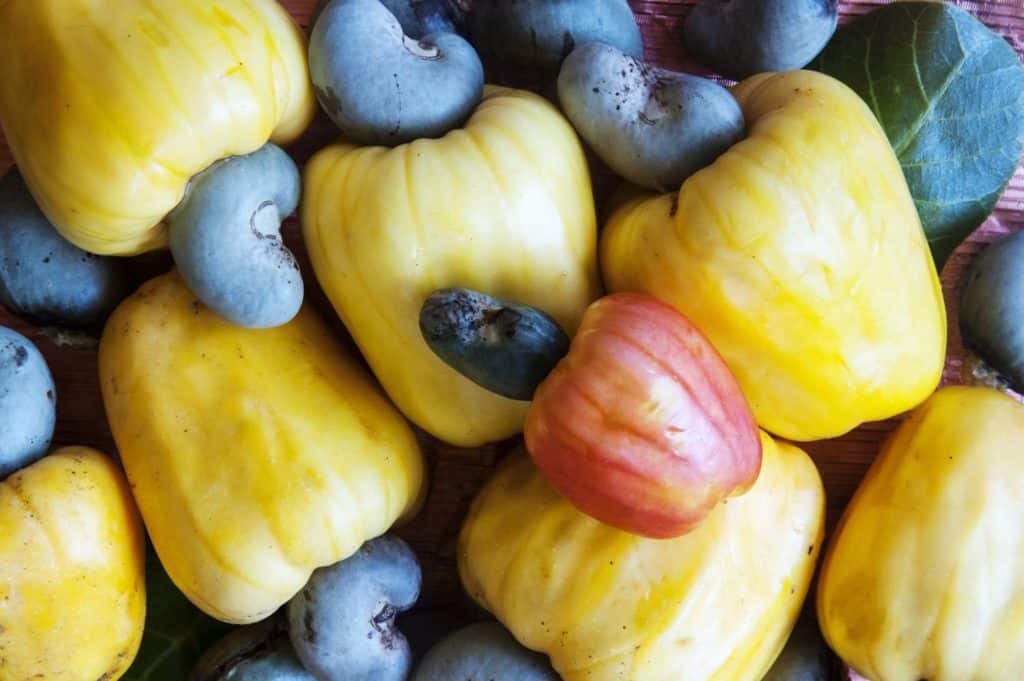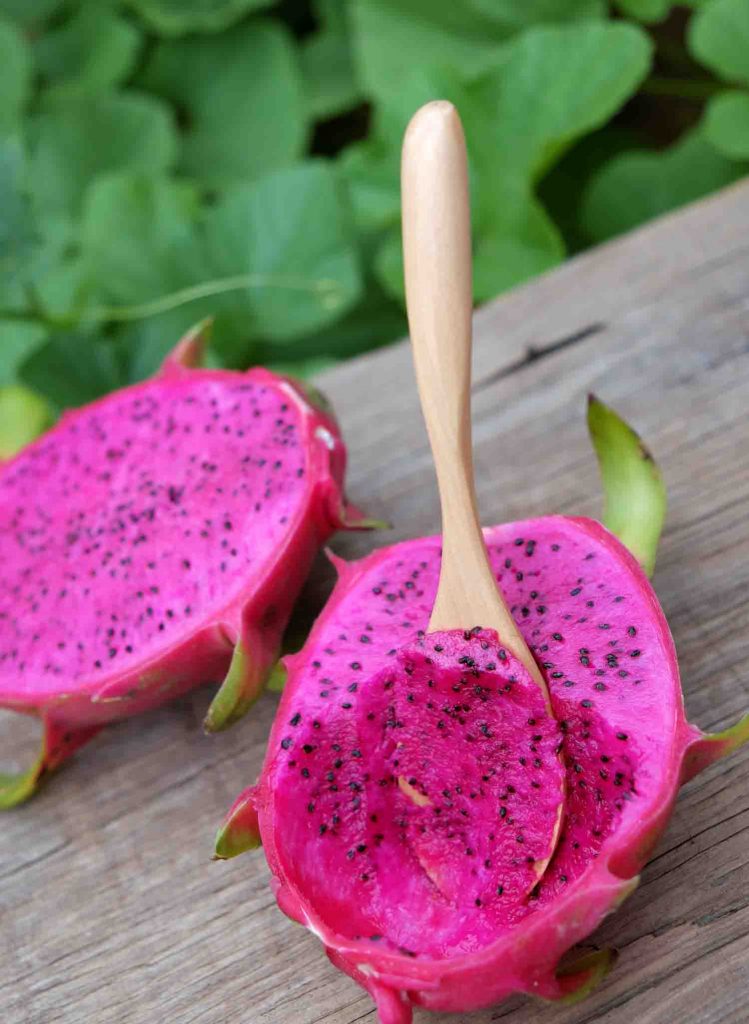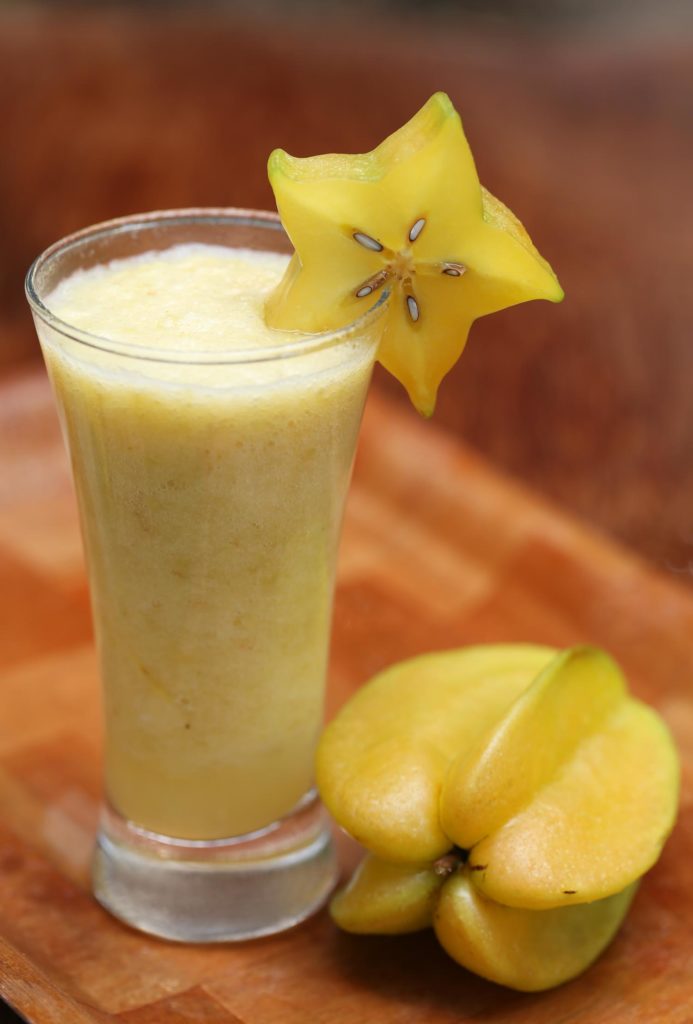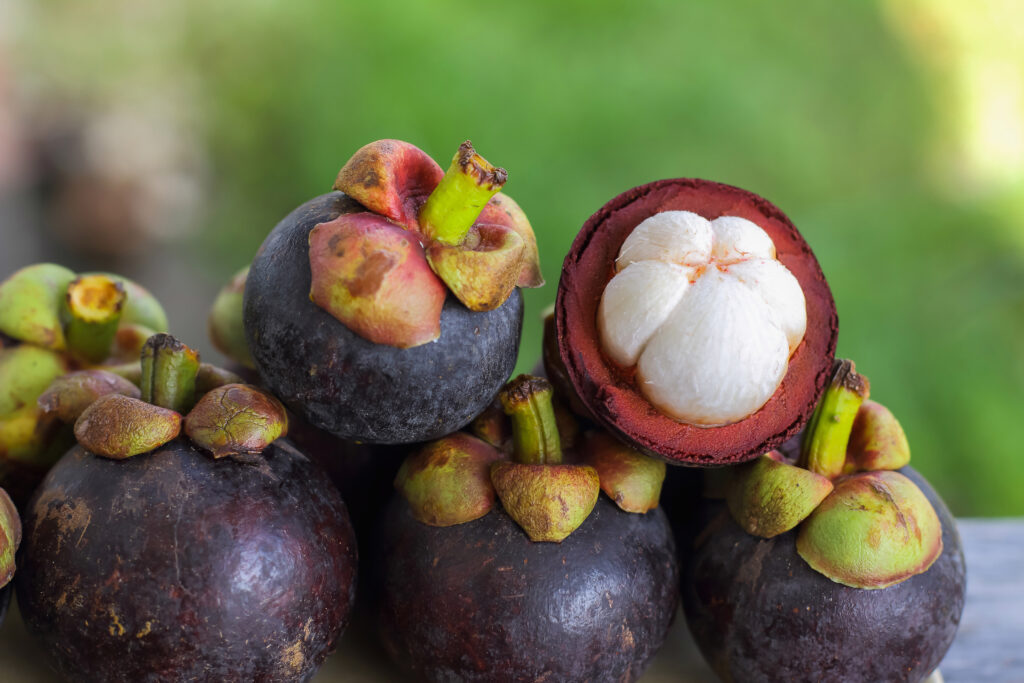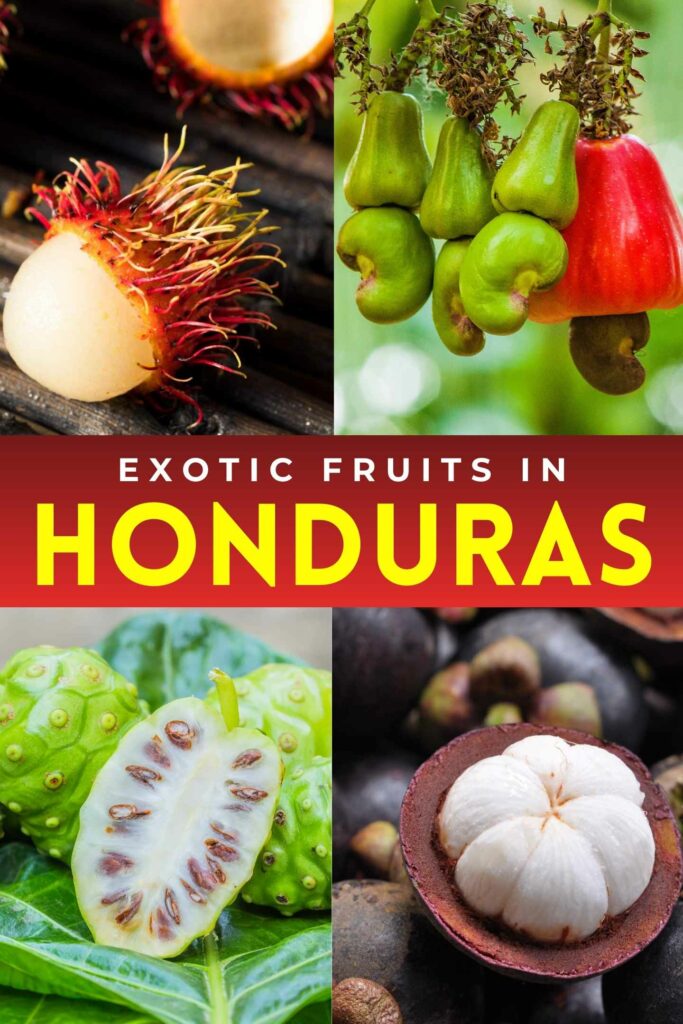This Central American country may be small, but fruits in Honduras will surprise you with flavors that’ll make your taste buds dance.
I have an unparalleled interest in fruit. Every time I travel somewhere new I look to see if there are any that I have not tried. I am fascinated how they traveled around the world historically, often through European colonization.
I’ve tasted a lot of fruit around the world. In fact, I usually research in advance so that I’m prepared to ask people where to find specific fruits in season.
Preparing for this trip I was so excited to see there were many Honduran fruits I had never heard of and do not exist in countries I had visited.
It can be intimidating to try new fruits when you aren’t sure exactly how to eat them. Many tropical fruits require peeling or at least squeezing the fruit until you can get inside.
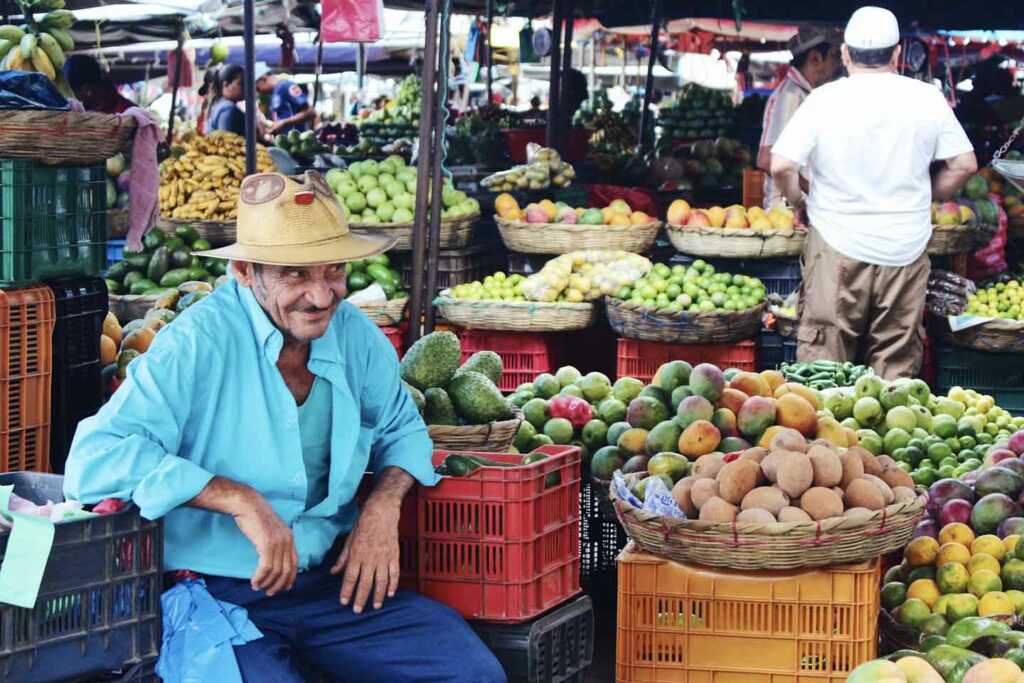
In Honduras the street vendors are incredibly friendly and will tell you how to eat it and let you try things, but be generous with them in return.
It is not easy selling fruit so always buy something from them.
I hope you find this list useful. spent a month exploring Honduras and met so many generous locals who helped me find what was in season.
I’ve included the scientific name because I’ve learned so many fruits look similar but are just from the same family.
Traditional Honduran Foods
Also please keep in mind that many of the health benefits are unproven by science so don’t go out and eat kilos of noni to cure cancer.
This is not medical advice. That said, often it takes a bit of time for modern medicine to catch up to what traditional medicinal practitioners knew all along.
.Exotic Fruits in Honduras
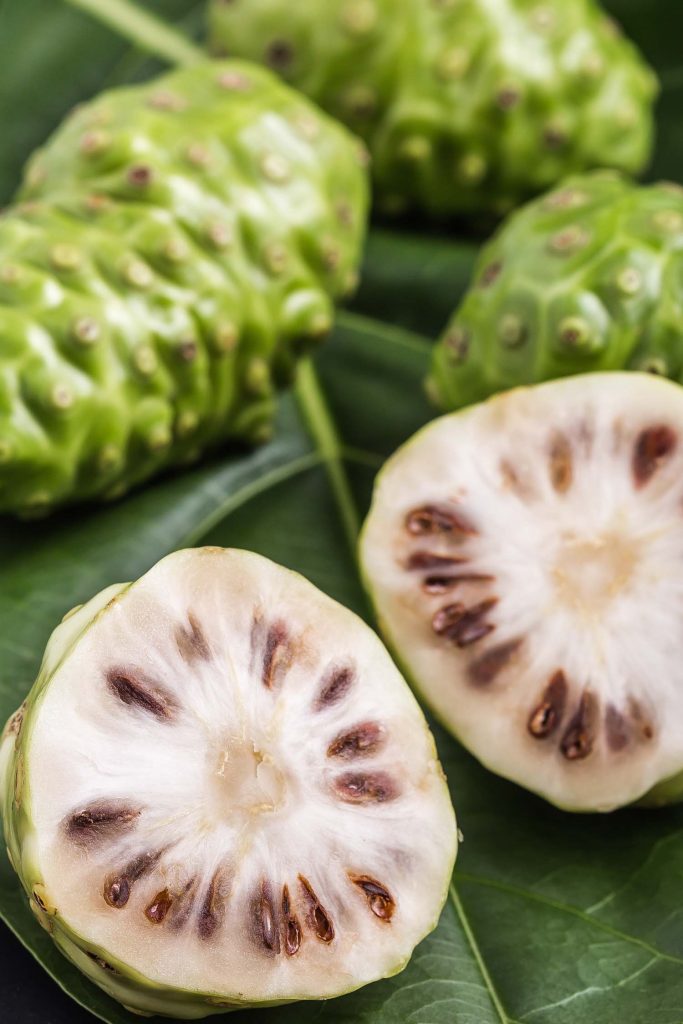
1. Noni | Miracle Fruit
Starting with the most polarizing fruit in Honduras – noni is truly an acquired taste that most people never acquire!
Native to Southeast Asia but now growing wild throughout Honduras, this bumpy, potato-sized fruit has an incredibly pungent smell that’ll hit you before you even see it. Think rotten cheese mixed with sweaty socks.
The taste is just as challenging – bitter, sour, and medicinal. But locals swear by its healing properties for everything from diabetes to digestive issues.
You’ll find noni trees everywhere in Honduras, especially along the north coast. Most people blend tiny amounts into smoothies with other fruits to mask the flavor, or take it as a supplement.
I first tried this fruit in Hawaii, I learned if you’re brave enough to try it straight, squeeze out the juice and gulp it fast. Don’t think about it too much.
Scientific Name: Morinda citrifolia
Common Name in other Countries: Great morinda, cheese fruit, Indian mulberry
Noni Season in Honduras: Throughout the year
Best Honduran Drinks
2. Mora de Castilla | Andean Blackberry
These aren’t your typical blackberries! Mora de castilla are larger, more elongated, and have a perfect balance of sweet and tart that’s absolutely addictive.
Native to the Andes they are common fruits in Ecuador. Yet they are also thriving in Honduras’ mountainous regions around Copán and the coffee-growing areas.
I found them in small mountain villages where locals eat them fresh or make incredible jams.
They’re packed with antioxidants and vitamin C. Perfect for hiking snacks in the cooler mountain regions of Honduras…or so I have been told as I don’t do much hiking.
Scientific Name: Rubus glaucus
Common Name in other Countries: Andean berry, Andean blackberry
Mora de Castilla Season in Honduras: May to September
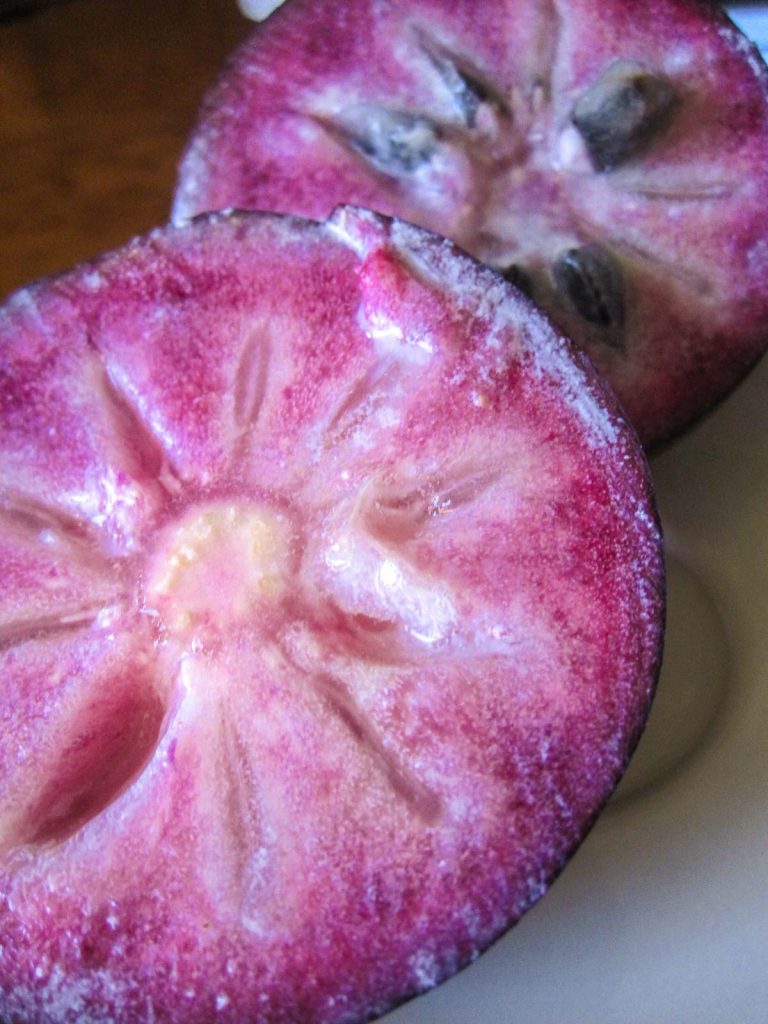
3. Caimito | Star Apple
The name says it all, cut this purple fruit open and you’ll see a perfect star pattern inside!
Caimito has a thick, purple skin that you don’t eat. Inside is sweet, translucent, jelly-like flesh that’s incredibly refreshing. The texture is unique, almost like eating sweetened jello.
Native to the Caribbean, it grows well along Honduras’ north coast. The fruit is about the size of an apple but much sweeter, with a custard-like consistency.
Locals often chill them before eating. The milk from the tree is sticky, so many people eat it with a spoon to avoid getting their hands messy.
Not surprisingly, it’s also a popular Nicaraguan fruit.
Scientific Name: Chrysophyllum cainito
Common Name in other Countries: Purple star apple, caimito morado
Caimito Season in Honduras: March to July
4. Higüero | Bottle Gourd Fruit
While most people know higüero as a gourd used for making bowls and containers, like the base of mate in Argentina the young fruit is actually edible and quite mild.
This long, cylindrical fruit has soft, whitish pulp when young that’s often used in traditional Honduran soups and stews. The flavor is very subtle, almost bland, which makes it perfect for absorbing other flavors in cooking.
You’re more likely to see mature higüeros being carved into bowls at markets, but ask around and you might find someone willing to let you try the young fruit.
It’s rich in fiber and has cooling properties, making it popular during Honduras’ hot season.
Scientific Name: Lagenaria siceraria
Common Name in other Countries: Bottle gourd, calabash
Higüero Season in Honduras: Throughout the year
5. Pera de Agua | Water Pear
Despite the name, this isn’t a pear at all! Pera de agua is a refreshing, watery fruit that’s perfect for Honduras’ tropical heat.
This greenish, bell-shaped fruit has incredibly crisp, juicy flesh that’s mildly sweet. It’s like biting into flavored water – incredibly refreshing but not overwhelming.
Popular throughout Central America, it’s often eaten as a palate cleanser or just for hydration. Street vendors sometimes sprinkle it with salt and chili powder.
The texture is similar to a very juicy apple, but the flavor is much more subtle. Perfect for hot days when you need something cooling.
It’s also a common fruit in Indonesia.
Scientific Name: Syzygium aqueum
Common Name in other Countries: Watery rose apple, water apple
Pera de Agua Season in Honduras: April to August
6. Nance | Golden Berry
I think many tourists walk by these tiny yellow fruits thinking they aren’t very interesting.
But they pack a flavor punch that’s both sweet and sour with a hint of cheese – yes, cheese!
Native to Central America, nance are about the size of cherries and grow in clusters. The flavor is hard to describe – imagine a mix of sweet cherry and aged cheese with a slightly fermented taste.
They’re incredibly popular throughout Honduras and are a local fruit in Guatemala as well. Kids love them, but adults often find the cheesy undertone off-putting at first.
Give it a few tries though, they’re addictive once you develop a taste for them.
Often eaten fresh or used to make traditional beverages. They’re also fermented to make alcoholic drinks in some regions.
Scientific Name: Byrsonima crassifolia
Common Name in other Countries: Nanche, hogberry, golden spoon
Nance Season in Honduras: May to September
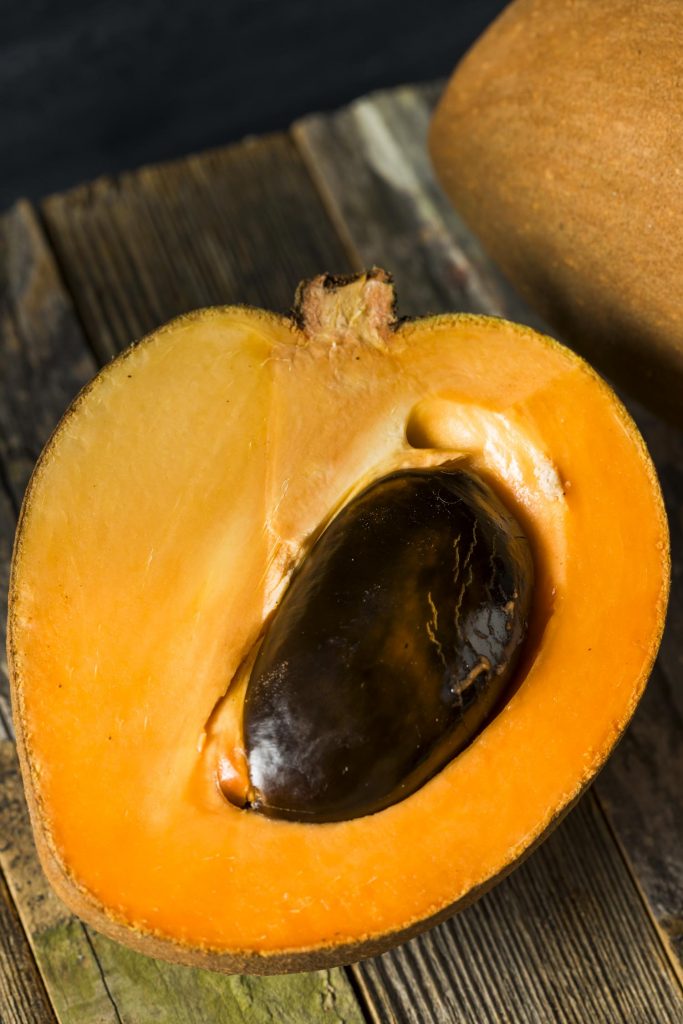
7. Zapote
This fruit looks like a brown potato on the outside, but inside is smooth, creamy flesh that tastes like caramel pudding mixed with sweet potato.
It’s absolutely divine.
Native to Central America, zapote is often called the chocolate fruit because of its rich, sweet flavor. The texture is soft and custard-like, perfect for eating with a spoon.
I first tried this Honduran fruit in Mexico and was blown away, it’s almost like an apple pie but as a fruit.
You’ll find it throughout Honduras, especially in markets. Look for fruits that yield slightly to pressure but aren’t mushy. The flesh should be dark brown when ripe.
Scientific Name: Pouteria sapota
Common Name in other Countries: Mamey sapote, sapote colorado
Zapote Season in Honduras: November to April
8. Jocote | Hog Plum
These are abundant fruits in Honduras but I think again most tourists pass by as they aren’t quite sure what to do with them.
Jocote are about the size of small plums with a large pit inside. They they come in shades from yellow to deep red and have a tart, refreshing flavor that’s perfect for hot weather.
The flavor ranges from quite sour when green to sweet-tart when ripe. They’re incredibly refreshing and often eaten with salt and chili.
Native to Central America, they’re found throughout Honduras. Street vendors often sell them in bags, and they’re popular with school children as a tart snack.
They’re rich in vitamin C and perfect for the tropical heat.
You can also find these fruits in Cuba where they are known as ciruelas.
Scientific Name: Spondias species
Common Name in other Countries: Hog plum, Spanish plum
Jocote Season in Honduras: March to June
9. Chirimoya | Sweetsop
One of my absolute favourite fruits around the world
If you only try one exotic fruit in Honduras, make it chirimoya. This green, scaly fruit contains what might be the most delicious flesh you’ve ever tasted.
The inside is creamy white with large black seeds, and the flavor is like a mix of banana, pineapple, and vanilla ice cream.
Native to the Andes, I discovered it as a Colombian fruit popular in smoothies. It also grows well in Honduras’ cooler mountain regions, chirimoya is often called the ice cream fruit for obvious reasons.
The skin and seeds aren’t edible, but the creamy flesh is pure heaven. It’s rich in vitamin C and natural sugars. Mark Twain called it “the most delicious fruit known to men” and he wasn’t wrong.
Scientific Name: Annona cherimola
Common Name in other Countries: Cherimoya, custard apple
Chirimoya Season in Honduras: November to March
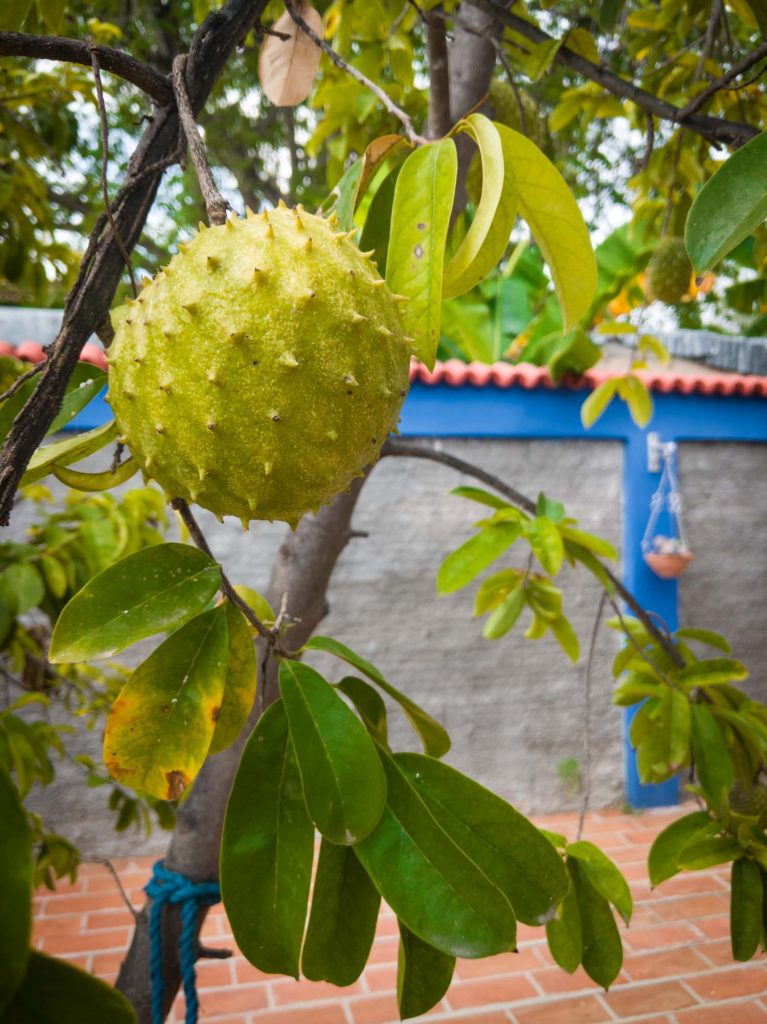
10. Guanábana | Soursop
Another member of the custard apple family, guanábana is a large, spiky green fruit with incredibly creamy, sweet-tart flesh inside.
It tastes a lot like cherimoya but has more intense flavours almost like a fruit cocktail of strawberry, pineapple and citrus.
The exterior is covered in soft spikes, but don’t let that intimidate you. Inside is white, cotton-like flesh dotted with black seeds.
Native to the Caribbean and Central America, it’s found throughout Honduras. The fruit can grow quite large, sometimes weighing several pounds.
It’s often used in smoothies, ice creams, and beverages. The flesh is incredibly refreshing and is believed to have medicinal properties, though these aren’t scientifically proven.
You can also find it as a common Sri Lankan fruit, but there it is known as katu anoda.
Scientific Name: Annona muricata
Common Name in other Countries: Soursop, graviola, guyabano
Guanábana Season in Honduras: June to September
11. Marañón | Cashew Apple
Here’s something that’ll blow your mind – the cashew nut you know grows on the outside of a fruit.
I had no idea until I saw them in a Brazilian fruit market.
The marañón consists of the cashew nut attached to the bottom of a bell-shaped, reddish-yellow fruit. The fruit itself is juicy and tangy with an astringent aftertaste that makes your mouth pucker.
While the nuts are exported worldwide, the fruit is usually consumed locally. It’s often made into juice, wine, or eaten fresh despite the strong, persistent aftertaste.
Native to Central America, cashew trees are common along Honduras’ north coast. The fruit is rich in vitamin C, even more than oranges, but that astringency means most people prefer it processed.
Scientific Name: Anacardium occidentale
Common Name in other Countries: Cashew fruit, caju
Marañón Season in Honduras: March to July
12. Pitahaya | Dragon fruit
With its bright pink exterior and dramatic green scales, pitahaya looks like something from a fantasy novel.
Inside may be white or pink. Maybe it’s the color but I find pink to be slightly sweeter. The flavor is mildly sweet with a hint of kiwi, and the texture is refreshingly crisp.
Originally from Central America, pitahaya grows well throughout Honduras. It’s incredibly photogenic and has become popular in smoothie bowls and health food circles.
The seeds are edible and add a nice crunch. It’s low in calories but high in antioxidants and vitamin C. Perfect for hot days when you want something refreshing but not too heavy.
It’s also one of the popular Bali fruits, where it is known as naga.
Scientific Name: Hylocereus undatus
Common Name in other Countries: Dragon fruit, strawberry pear, naga
Pitahaya Season in Honduras: July to November
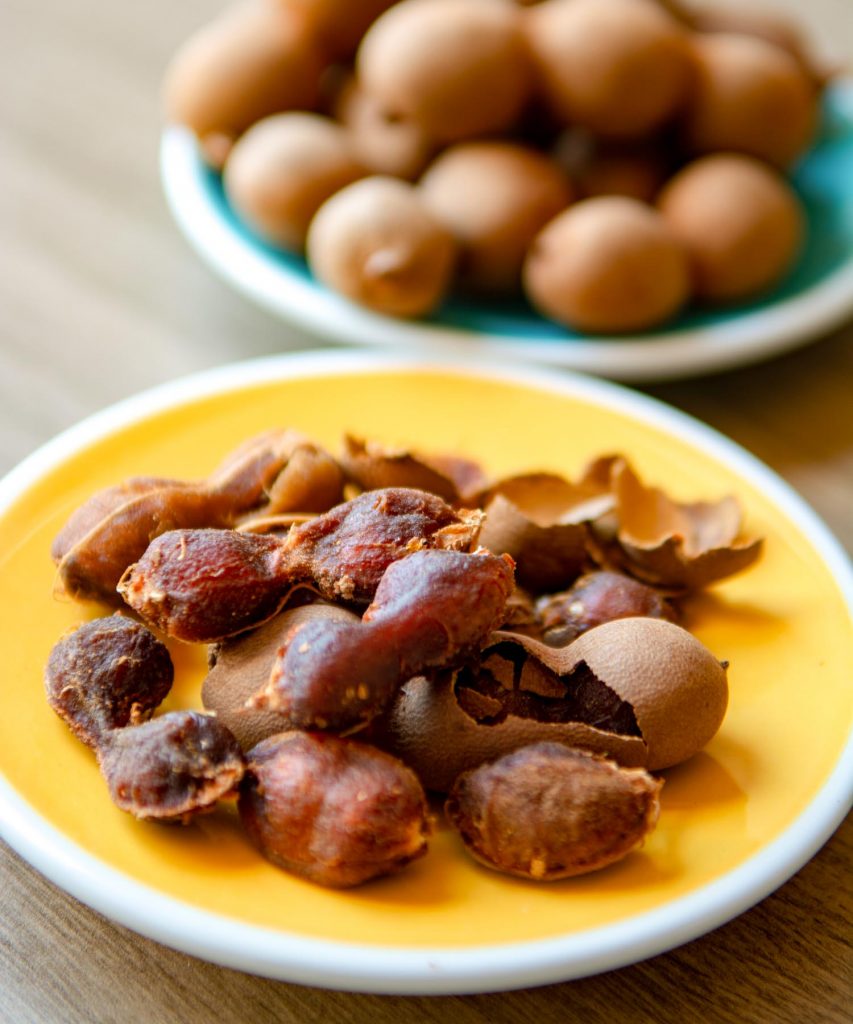
13. Tamarindo | Tamarind
Tamarindo pods look like oversized brown pea pods, but inside they contain sticky, tart-sweet pulp that’s used throughout Latin America and South East ASia.
The flavor is complex: sour, sweet and slightly fruity with hints of dates. It’s often eaten fresh, but the pulp is also used to make beverages, candies and sauces.
Native to Africa but now naturalized throughout Central America, tamarind trees are common in Honduras. The pods contain seeds surrounded by the edible pulp.
It’s incredibly popular in Mexican and Central American cuisine. In Honduras, you’ll find tamarindo agua fresca at many street vendors. It’s rich in tartaric acid and has a unique tangy flavor.
It’s a very popular Malaysian fruit as well where they cook with it to create sweet and sour dishes.
Scientific Name: Tamarindus indica
Common Name in other Countries: Tamarindo, tamarin
Tamarindo Season in Honduras: December to May
14. Carambola | Starfruit
When sliced, carambola creates perfect five-pointed stars, making it one of the most photogenic fruits in Honduras.
Native to Southeast Asia but now growing throughout tropical America, carambola trees are common in Honduran gardens and small farms.
The entire fruit is edible, including the waxy skin but I have never seen anyone eat the skin. When ripe, it’s sweet and juicy with a crisp texture like a cross between an apple and a grape. When unripe, it’s quite sour.
In most Latin American countries it is mixed with a lot of sugar to make juice. But I really love that in Vietnam they embrace sourness and they use this Vietnamese fruit to add sour to soups and other dishes.
The flavor varies greatly depending on ripeness. Look for yellow fruits with minimal green for the sweetest experience. It’s high in vitamin C and makes beautiful garnishes.
Scientific Name: Averrhoa carambola
Common Name in other Countries: Star fruit, five finger, khế
Carambola Season in Honduras: September to February
15. Guayaba | Guava
The fragrance of ripe guayaba will hit you before you even see the fruit.
These round, yellow-green fruits have pink or white flesh inside dotted with small, edible seeds. The flavor is sweet and floral..
The entire fruit is edible, including the skin and seeds. It’s surprising that people haven’t started to call it a super fruit as it’s so high in fiber and has more vitamin C than citrus.
Color matters as you’ll see both pink and white guavas. White guavas have a milder, less tangy flavor compared to pink guavas, which are sweeter.
No one knows definitively where guavas came from in the America but many believe the Amazon. And yet today they reach all over the world and are common fruits in Laos.
Scientific Name: Psidium guajava
Common Name in other Countries: Guava, bayabas
Guayaba Season in Honduras: Throughout the year

16. Guineo | Sweet Baby Bananas
These aren’t your grocery store bananas! Guineos are small, sweet bananas with incredibly intense flavor.
Much smaller than commercial bananas, guineos are often eaten fresh when perfectly ripe,they’re much sweeter and more flavorful than the Cavendish bananas most people know.
They grow wild throughout Honduras and are a staple in local diets. The flavor is concentrated and honey-like, with a creamy texture that’s absolutely divine.
You’ll find them in markets throughout Honduras, usually in small bunches. They’re perfect for snacking and are often used in traditional desserts and smoothies.
Scientific Name: Musa species
Common Name in other Countries: Lady finger banana, baby banana
Guineo Season in Honduras: Throughout the year
17. Coco | Coconut
Perhaps you’ve had coconut at home, but it’s nothing compared to having it fresh.
Coconut palms line Honduras’ Caribbean coast, and you’ll find vendors everywhere chopping open fresh coconuts with machetes. The water is naturally sterile and packed with electrolytes. Just be careful not to have too much coconut water as it can be a laxative.
Young green coconuts provide the clearest, most refreshing coconut water you’ll ever taste. The meat is soft and jelly-like, perfect for eating with a spoon.
As the coconuts mature, the meat becomes firmer and is used for cooking, making milk, and eating fresh. The versatility of coconuts makes them incredibly valuable in Honduran cuisine.
Scientific Name: Cocos nucifera
Common Name in other Countries: Coconut, coco
Coco Season in Honduras: Throughout the year
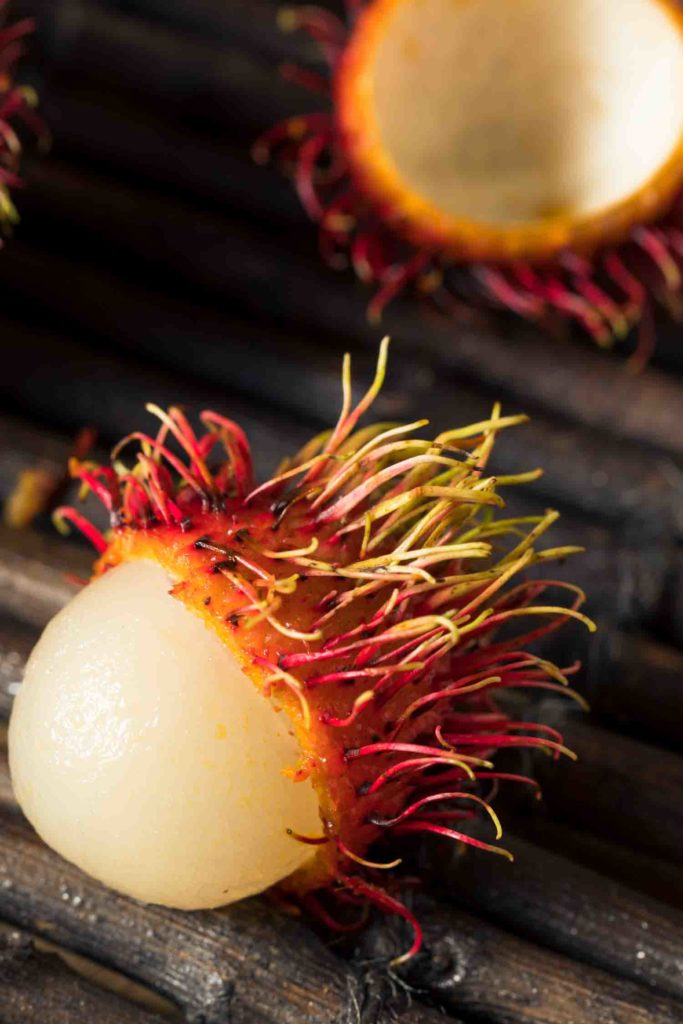
18. Rambutan
These golf ball-sized fruits are covered in soft, red hairy spikes that make them look like something from an alien planet.
Don’t be intimidated by the appearance. Simply squeeze the fruit and it pops open to reveal translucent white flesh that’s sweet and floral. The texture is similar to grapes but firmer. They are similar to a lychee.
Originally from Southeast Asia and are popular street fruits in Thailand, rambutan trees were brought to Honduras and now grow well along the north coast.
There’s a seed inside, so eat around it carefully. Pop it in your mouth and suck the fresh off the pit.
Scientific Name: Nephelium lappaceum
Common Name in other Countries: Lichas, chôm chôm
Rambutan Season in Honduras: June to September
19. Mangosteen
If rambutan is impressive, mangosteen is absolutely royal. This purple fruit with thick skin contains some of the most delicious flesh you’ll ever taste.
The exterior looks like a purple tomato, but you need to squeeze hard to crack it open. Inside are white segments that look like garlic cloves but taste like heaven – sweet, tangy, and incredibly juicy.
Originally from Southeast Asia, mangosteen trees take about 10 years to produce fruit, making them rare and expensive. You’re most likely to find them along Honduras’ north coast.
The flavor is indescribable: tropical, sweet, with hints of peach and pineapple. It’s truly worth seeking out and is considered one of the world’s finest fruits.
Scientific Name: Garcinia mangostana
Common Name in other Countries: Purple mangosteen
Mangosteen Season in Honduras: May to August
